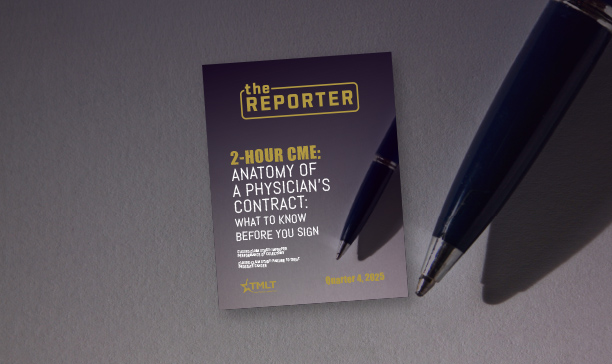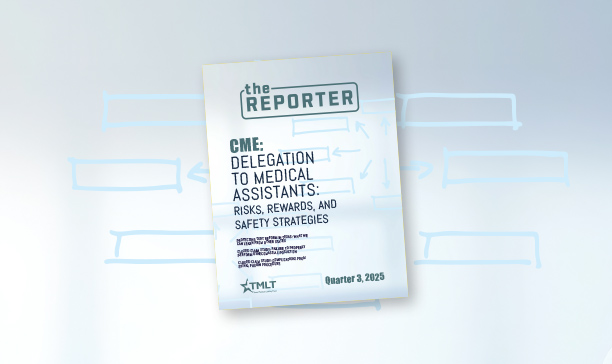Failure to diagnose hemothorax
A 26-year-old pregnant woman came to the ED. The patient was experiencing tachycardia and her labs showed she was anemic. Her medical history included takotsubo cardiomyopathy.
Presentation
A 26-year-old woman came to the emergency department (ED) of a local hospital. She was 35 weeks pregnant. She reported one episode of syncope, as well as headache, chest pain, shortness of breath, fatigue, weakness, and spontaneous bruising and swelling in her arms. The patient was experiencing tachycardia and her labs showed she was anemic. Her medical history included takotsubo cardiomyopathy (TCM).
Physician action
The emergency medicine (EM) physician ordered a CT scan with contrast of the head and chest. Radiologist A — who described the chest images as suboptimal — interpreted the images as showing a moderate to large plural effusion with atelectasis/consolidation in the left lower lobe. She documented that there was no evidence of pneumothorax or pulmonary embolism, but the heart was slightly enlarged with a small pericardial effusion.
The patient was admitted under the care of a cardiologist. When he examined the patient the next morning, he diagnosed sepsis and ordered her transfer to the ICU. The cardiologist also requested additional consults.
Because the results of a biophysical profile ordered by the patient’s ob-gyn were concerning, the ob-gyn took the patient to the OR for an emergency cesarean delivery. After the baby was delivered, the patient experienced a postoperative cardiovascular collapse. Resuscitation efforts included transfusion, CPR, and ECMO, but the patient died. The pathologist reported the cause of death as cardiomyopathy.
Allegations
A lawsuit was filed against the radiologist, alleging that she misinterpreted the CT scan and failed to diagnose a hemothorax.
Legal implications
Of issue in this case was the finding from the CT scan of a mediastinal shift of the patient’s trachea and esophagus. Radiologist A did not comment on this finding. The plaintiff’s radiology expert was critical of this omission, arguing that the fluid was blood that extended into the mediastinum. This expert said the study showed a rounded structure that he believed to be an aneurysm or pseudoaneurysm of the left internal mammary artery.
Based on these findings and the patient’s symptoms, the plaintiffs alleged that a proper interpretation of the CT scan would have led to a surgical consultation and placement of a chest tube. The patient then would have received blood transfusions and treatment to stop the bleeding. Instead, the patient’s volume depletion, lung and mediastinal compression, along with her pregnancy and heart condition led to her death.
This was a complicated and unusual case. Two radiologists who reviewed this case for the defense concluded that there was a significant, abnormal density in the anterior mediastinum visible on the CT images. This density could be consistent with a hemorrhage and was displacing the trachea and esophagus.
Yet, despite reviews from multiple experts in multiple specialties, there was no theory that could explain all the patient’s clinical signs and symptoms. The defense theory that the patient developed an infectious process that led to disseminated intravascular coagulation and death did not explain her anemia and bruising, and that the cultures were negative for infection.
Disposition
This case was settled on behalf of the radiologist.
Risk management considerations for radiologists
Disclaimer
Presentation
A 26-year-old woman came to the emergency department (ED) of a local hospital. She was 35 weeks pregnant. She reported one episode of syncope, as well as headache, chest pain, shortness of breath, fatigue, weakness, and spontaneous bruising and swelling in her arms. The patient was experiencing tachycardia and her labs showed she was anemic. Her medical history included takotsubo cardiomyopathy (TCM).
Physician action
The emergency medicine (EM) physician ordered a CT scan with contrast of the head and chest. Radiologist A — who described the chest images as suboptimal — interpreted the images as showing a moderate to large plural effusion with atelectasis/consolidation in the left lower lobe. She documented that there was no evidence of pneumothorax or pulmonary embolism, but the heart was slightly enlarged with a small pericardial effusion.
The patient was admitted under the care of a cardiologist. When he examined the patient the next morning, he diagnosed sepsis and ordered her transfer to the ICU. The cardiologist also requested additional consults.
Because the results of a biophysical profile ordered by the patient’s ob-gyn were concerning, the ob-gyn took the patient to the OR for an emergency cesarean delivery. After the baby was delivered, the patient experienced a postoperative cardiovascular collapse. Resuscitation efforts included transfusion, CPR, and ECMO, but the patient died. The pathologist reported the cause of death as cardiomyopathy.
Allegations
A lawsuit was filed against the radiologist, alleging that she misinterpreted the CT scan and failed to diagnose a hemothorax.
Legal implications
Of issue in this case was the finding from the CT scan of a mediastinal shift of the patient’s trachea and esophagus. Radiologist A did not comment on this finding. The plaintiff’s radiology expert was critical of this omission, arguing that the fluid was blood that extended into the mediastinum. This expert said the study showed a rounded structure that he believed to be an aneurysm or pseudoaneurysm of the left internal mammary artery.
Based on these findings and the patient’s symptoms, the plaintiffs alleged that a proper interpretation of the CT scan would have led to a surgical consultation and placement of a chest tube. The patient then would have received blood transfusions and treatment to stop the bleeding. Instead, the patient’s volume depletion, lung and mediastinal compression, along with her pregnancy and heart condition led to her death.
This was a complicated and unusual case. Two radiologists who reviewed this case for the defense concluded that there was a significant, abnormal density in the anterior mediastinum visible on the CT images. This density could be consistent with a hemorrhage and was displacing the trachea and esophagus.
Yet, despite reviews from multiple experts in multiple specialties, there was no theory that could explain all the patient’s clinical signs and symptoms. The defense theory that the patient developed an infectious process that led to disseminated intravascular coagulation and death did not explain her anemia and bruising, and that the cultures were negative for infection.
Disposition
This case was settled on behalf of the radiologist.
Risk management considerations for radiologists
Disclaimer
Want to save this article for later?
Download the full article as a PDF for future reference or to share with colleagues.
Subscribe to Case Closed to receive insights from resolved cases.
You’ll receive two closed claim studies every month. These closed claim studies are provided to help physicians improve patient safety and reduce potential liability risks that may arise when treating patients.
Related Resources
Discover more insights, stories, and resources to keep you informed and inspired.





